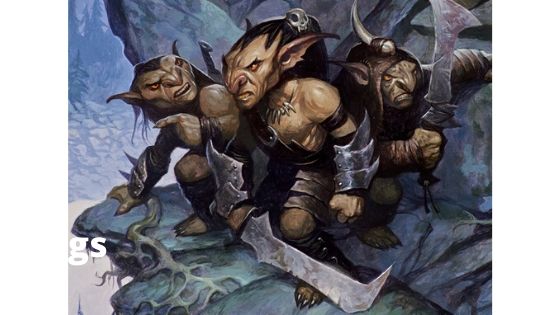Running goblins in D&D can be done in an interesting way that will keep players interested. There are a few different ways to use goblins in order to make them more interesting.
Running goblins in D&D can be done by either making them funny or vicious. They can be a bit of both, but goblins can be unique game to game.
I used to run goblins as simple stat block monsters, but after exploring more about them and their culture you will find that there are more to goblins than initially meets the eye.
Goblin nature
Understanding goblin nature is essential to running goblins in D&D. If you don’t understand how goblins naturally work then you will most likely just use them as a stat block. So, to put it in simple terms, here is their nature.
Goblins naturally are cruel and vicious little things. If left unchecked they will kill small animals and destroy for fun. But, they are dumb. In their stupidity, they are naive and can possibly be redeemed.
The limit on how redeemable goblins are is up to the DM. There are three different levels of redemption that DMs can allow goblins:
- They are just misguided creatures forced to live this way.
- It is cultural but changeable.
- These monsters will only enjoy carnage.
In all instances, goblins are naturally evil. They are at best stupid creatures that kill because it is fun or the logical thing to do. Think about a little kid. If they are hit by someone they want to hit them back. An eye for an eye. That or they do the hitting for some perceived slight that could be real or imaginary.
In no instance are goblins naturally good creatures, but they can become good through cultural adaptation and laws.
Understanding goblin nature is extremely important to running goblins correctly. I have seen some games where goblins are just stupid funny creatures, but that shouldn’t be the case.
We are going to go over each level of goblin cruelty/innocence and how to play them in your game. So stick around and learn something that will help you create an even better campaign!
Misguided
The lowest level of cruelty that you can have when running goblins in D&D is the idea that goblins are just misguided. They are cute little buggers that will tear your heart out and be more adorable than any child could.
I do not think that this is possible in D&D from a logical standpoint. They are evil creatures and will have evil tendencys. The idea that goblins are just cute misguided victims is a little too optimistic.
Yes, goblins are the fodder for other evil races and sometimes used as toys for other races but being a victim doesn’t make you less evil. It gives you sympathetic story that others might resonate with, but it doesn’t make you better. This is where goblins can shine, but they are never just misguided good creatures.
You can make an argument that their culture is what makes a goblin evil, but even then all goblins are raised to be evil. The only time they are possibly not evil is as a baby and even then they might be.
Instead of portraying goblins as poor innocent creatures that have just been subjected to a harsh life or culture, we should view them in a different light when making them cute.
Cuties that will cut you

Goblins are evil. It can be by culture or nature, but they are all evil. This does not mean that every goblin must be a vicious creature with no redeeming qualities.
In this level of cruelty your goblins are naturally vicious but willing to learn and change. If you are running goblins in D&D like this, then you have a lot of opportunities presented to you.
Goblins of this nature are evil but cowardly. They will turn on each other and change their world views if someone will spare their life. Power also can change how a goblin thinks. If an adventurer spares a goblin they might follow and worship the adventurer while trying to be good.
These goblins are still the naturally vicious creatures out there but they can and most likely will be redeemed. If the players do not just slaughter goblins they will start to learn about their pathetic culture and most likely pity them. This pity and understanding allows for many opportunities.
If your players are into roleplay this can be a great opportunity to enhance your game. Giving goblins this redeeming quality will make monsters seem less black and white for good and evil. Your players might try to reason with ogres, trolls, and make your game of D&D very unique.
This is probably the best way to use goblins if your group is into roleplay at all. They will still cut the players without hesitation, but when shown that they are inferior will try to seem appeasing. It fits the goblin’s cowardly nature adds an extra element to your game making it a win/win.
Goblins are still cowards and will fight with cowardly means so look further down in our article to figure out how goblins fight. If you want to establish that your goblins are monsters but players want to try and redeem them, you might have a cultural issue.
Cultural
Goblins come from a harsh culture. They are the bottom of the totem pole for most evil races and goblins know it. They don’t want to die and are extremely cowardly, but they will still fight. Why will they still fight and what does that knowledge do to a goblin?
The only way to cope with natural selection for a goblin is by making a culture for themselves. They don’t have to have a sophisticated culture, but they should have a culture nonetheless.
Goblin culture almost always includes the rule of the strong. Goblins due to being forced to follow strong creatures have realized that following the strong is the only way to survive. They have also learned that no other morals matter.
If a goblin kills someone for taking a bite of their bread, the goblin who killed the other is right because they are stronger. Might makes right in a goblin society and that can lead to some issues. When running goblins in D&D think about how your life would be if you lived by this principal. Now consider something core to your personality. Can you change it?
Might makes right is ingrained in a goblin’s core values. Changing that is almost impossible and even if the goblin wants to be good it is extremely hard to do so because of this. That is where you can get into some pathetic and interesting situations.
If a goblin goes to a big city, they might try to kill someone in order to get their shoes. If they are reasoned with the person reasoning with the goblin might find themselves at an impasse. The goblin cannot understand money or empathy. It is just against everything that goblins know. The goblin will pretend to understand because it respects the power other wield.
In these circumstances goblins are like stray animals who will hurt others. They will eventually need to be put down, but it doesn’t make it any less sad.
Goblins’ portrait in this light can eventually learn and adapt to the new culture, but it will take a long time. Generally, far longer than anyone will have the patience or money for.
True monsters

If you are running goblins in D&D like this then you are most likely playing a hack and slash game. Playing a hack and slash game is okay as we described in our article, but you might also be playing a grimdark game where death and destruction are daily occurrences.
When running goblins in this manner, they are ruthless. Goblins only live to kill and slaughter others. All semblance of personality is only there to terrify people. Goblins might be cowardly upon death, but even in the instant of their death, they might be looking for a way to kill their perpetrator.
For these goblins they have no redeeming qualities whatsoever.
The extent of how far you want to take this is up to you the DM. They could just be murdering monsters or clever little tricky monsters that will wave a person’s head at others to inspire fear. You can go into more detail, but I will not since not everyone is okay with even reading how messed up goblins can be.
These monsters need to be put down and however far you and your table are willing to take it is up to you. Just know that goblins can be truly horrifying creatures that can be more cruel and vicious than the Spanish Inquisition or any other human organization. This is because they don’t need logic or reason to do what they want. Being evil is just fun.
Goblin combat intelligence
At any point when you are running goblins in D&D you will need to know how to use them in combat. Ogres and trolls are obvious. You just have them go in hack, smash, and die. This is common for most monsters in D&D like beasts, elementals, etc.
Goblins are different than many other creatures in D&D.
They are small creatures that are cowardly and know that they are at the bottom of the totem pole. We have talked about this a few times already. Knowing how weak they are and being cowardly in nature makes goblins fight in a different manner than most of the monsters in D&D do.
Goblins have a 10 intelligence. Contrary to popular belief, they are as smart as humans. Kobolds have an 8 intelligence, so they are stupider but goblins are actually quite smart. Goblins do not apply their intelligence towards bettering their lives or their society. Instead, they apply their intelligence towards survival.
Using intelligence to survive can mean many things, but the main area that they apply their intelligence in is how to fight in combat.
Goblin combat tactics

Goblins don’t want to die, and when fighting a strong opponent they will either overwhelm them, use something to gain an advantage, or not run away.
Overwhelming is simple, but gaining an advantage can be anything. It could be shooting a powerful opponent when they are unable to move or making their targets unable to see while goblins can. If they cannot do this, they will run away and only fight when cornered. Even then, it is likely they will beg for their life depending on the goblins that you are running.
Lastly, goblins will use traps. People can make a wide array of traps. Goblins are just as smart as people and will practice trap making more than most of the people out there. This means that their traps should be particularly nasty and the preferable method that goblins will fight with. Why fight a powerful opponent head to head when they can fall and crack their head?
This is probably the most frustrating way for player to have DMs running goblins in D&D. Players are not in for a standard fight and having to deal with retreating goblins who have traps placed everywhere is different than most combats. It can make the combat turn into a horror session.
Combat is short due to hit and run tactics, the environment is the enemy, and the mystery is in what the goblins have in store for the players next.
Goblin combat tactics are going to cause even the most seasoned adventurers to proceed with caution if used correctly.
Conclusion
Goblins are cowardly evil creatures that can be redeemable. This depends on the DM and how redeemable you want your little green menaces to be, but goblins can be interesting cute creatures to run.
If you have a group that likes to roleplay, this is possibly the best way to go about running goblins in D&D.
Conversely, if you have a group that is based on hack and slash combat you should embrace the monstrous side of goblins. Make them true monsters, but only take it as far as your group is willing to take it. Don’t go above what people are okay with.
You can run goblins as cute misguided creatures, but as stated above that doesn’t make sense in D&D. They are inherently evil, so run them as cute and potentially redeemable. Just don’t make them seem like a poor victimized race with no issues other than oppression.
Goblin combat is different than any other form of combat in D&D. These little cretins will not fight fair and are actually quite smart. Use that to make your goblin encounters memorable.
I hope that I have helped you understand how to run goblins in D&D a little bit, and that your game has improved by reading this.
Until next time this has been Wizo and keep rolling!




